November 23rd, 2025
Top 10 AI Tools for Research in 2025: Features & Pricing
By Zach Perkel · 28 min read
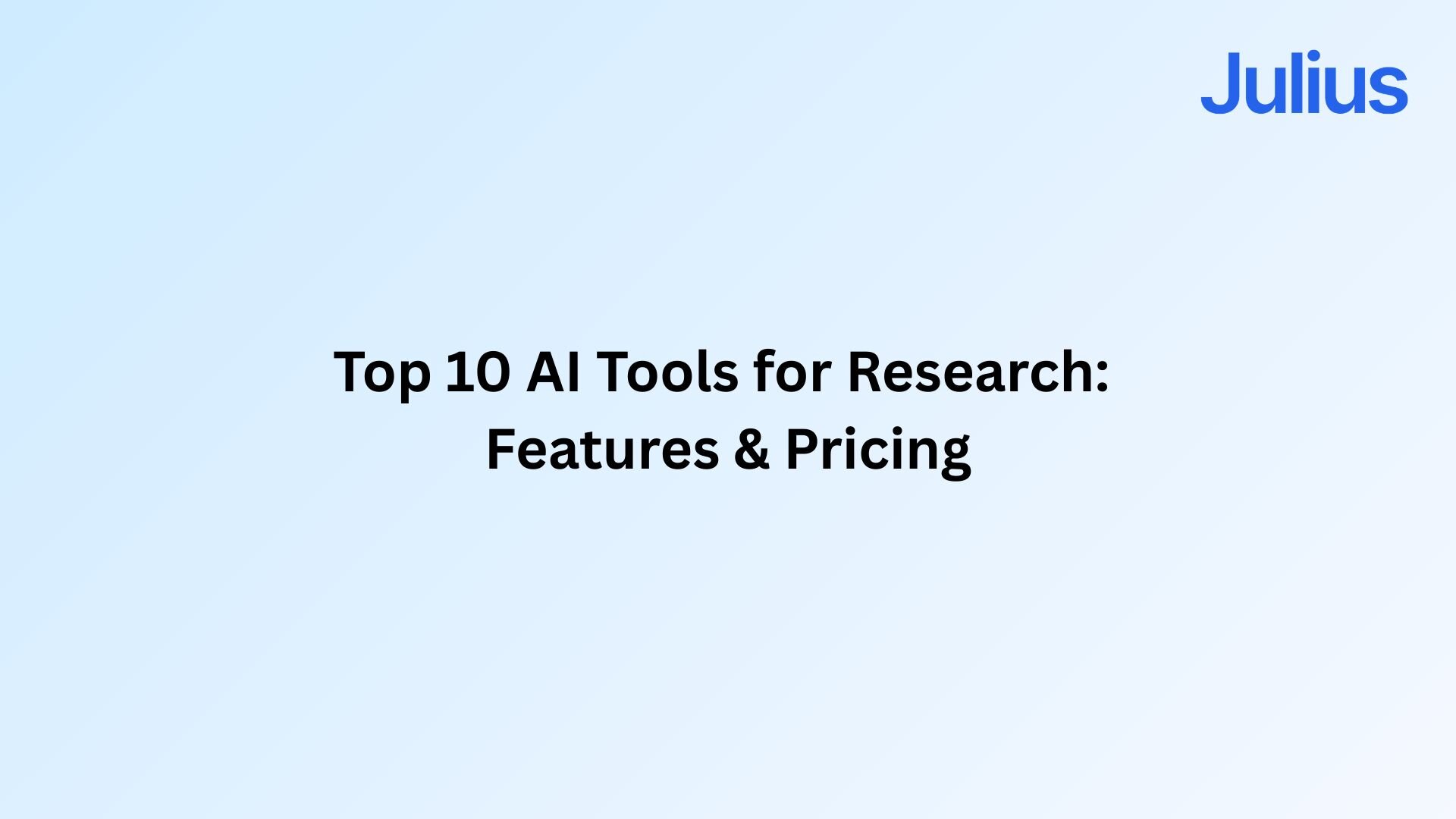
After testing AI tools for research across projects and datasets, I found the 10 best platforms that consistently produced insights in 2025.
Expert take:
Julius fits best if you want quick analysis, charts, and repeatable workflows without coding. Elicit and Consensus help you evaluate studies, while Research Rabbit and Scite make it easier to map related papers and verify claims.
10 Top AI tools for research: At a glance
AI tools for research cover everything from source discovery to data analysis, so the right pick depends on how you work and what each project requires. Here are the top 10 tools in 2025 compared side by side:
Tool | Best For | Starting Price (Billed Annually) | Key Strength |
|---|---|---|---|
Data-focused research | Fast analysis with natural language queries | ||
Literature review support | Structured summaries of academic papers | ||
Evidence-based answers | Clear results from peer-reviewed studies | ||
Exploring paper networks | Visual maps of related research | ||
Verifying claims | Citation context that shows support or dispute | ||
Quick topic scans | $20/month billed monthly | Fast answers with linked sources | |
Paper recommendations | Matches uploaded docs to related research | ||
Reading and questioning PDFs | Detailed explanations of uploaded papers | ||
Summaries from documents | $8.25/month | Simple PDF querying and extraction | |
Summarizing research papers | Fast AI summaries with key points and highlights |
1. Julius: Best for data-focused research
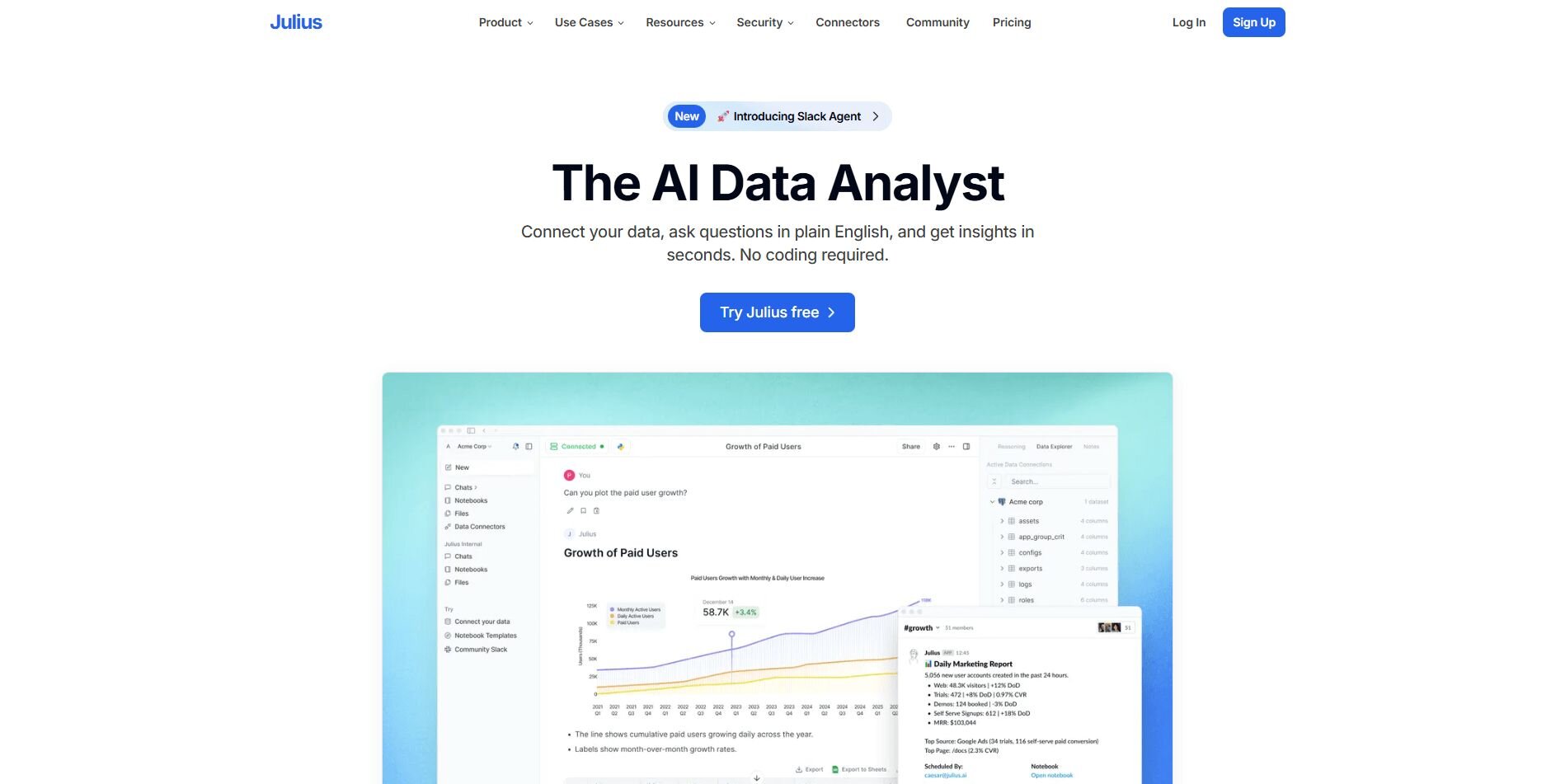
What it does: Julius is an AI data analysis tool that turns connected datasets into charts, summaries, and scheduled reports. You can connect your databases or Google Sheets and explore metrics through natural language without writing SQL.
Who it’s for: Researchers who work with structured data and want quick visual analysis without coding.
We designed Julius to support researchers who work with structured data. When you connect your sources, you can ask questions about patterns, comparisons, or segment differences and get charts that point directly to the underlying tables. That helps you move from raw metrics to clearer findings without writing SQL.
You can look at changes across groups, time periods, or regions to see how results vary. The source links show which tables and columns drive each metric, which helps you confirm accuracy before adding numbers to a report or presentation.
We also included Notebooks for recurring summaries on a weekly or monthly schedule. Julius refreshes them automatically and sends updates to Slack or your inbox so you can keep ongoing analysis organized.
Over time, Julius learns how your tables connect. It uses that structure to pull from the correct fields and return more consistent answers as you run new questions.
Key features
Natural language analysis: Ask questions and get visual answers
Connected data sources: Works with Postgres, BigQuery, and Google Sheets
Reusable Notebooks: Save recurring checks that auto refresh
Scheduled reporting: Send recurring results to Slack or email
Table relationship learning: Improves column and join accuracy over time
Pros
Quick setup for structured data
Clear charts for exploratory analysis
Automated recurring updates
Cons
Built more for business research than academic-level statistics
Requires clean, consistent data
Pricing
Julius starts at $16 per month.
Bottom line
Julius helps you review business data through natural language and clear visuals so you can check trends without writing SQL. It’s a strong fit when your research depends on performance metrics or recurring checks. If you need academic summaries or citation analysis, Elicit or Scite will cover those gaps.
2. Elicit: Best for literature review support

What it does: Elicit uses AI to search academic databases, summarize papers, and present findings in a structured table. It extracts details like methods and outcomes so you can compare studies quickly. It also supports natural language queries to help you narrow your topic.
Who it’s for: Researchers who need organized summaries of scholarly papers.
I tested Elicit to understand how it handles early-stage research, and the table view made it easy to scan several studies at once. Seeing titles, methods, and results lined up like that helped me narrow broad questions without scanning each paper individually.
Filtering the list showed how different researchers approached the same topic, which saved time when I only needed a quick sense of the overall direction. Opening a summary gave enough detail to decide whether a paper deserved a deeper read.
What stood out most was how flexible the columns were across different fields. It made it easier to compare studies even when the terminology wasn’t consistent, and it gave a clearer sense of how each paper framed the problem.
Key features
Research tables: Compare studies in one view
Paper summaries: Review key points fast
Natural language search: Ask structured questions
Pros
Clear summaries of academic sources
Strong table organization
Helpful for narrowing broad topics
Cons
May miss niche studies
Requires rewording questions for better results
Pricing
Elicit starts at $10 per user per month.
Bottom line
Elicit helps you organize and review academic papers without reading everything end-to-end. If your work focuses on research consensus or factual claims, Consensus may be more direct.
3. Consensus: Best for evidence-based answers
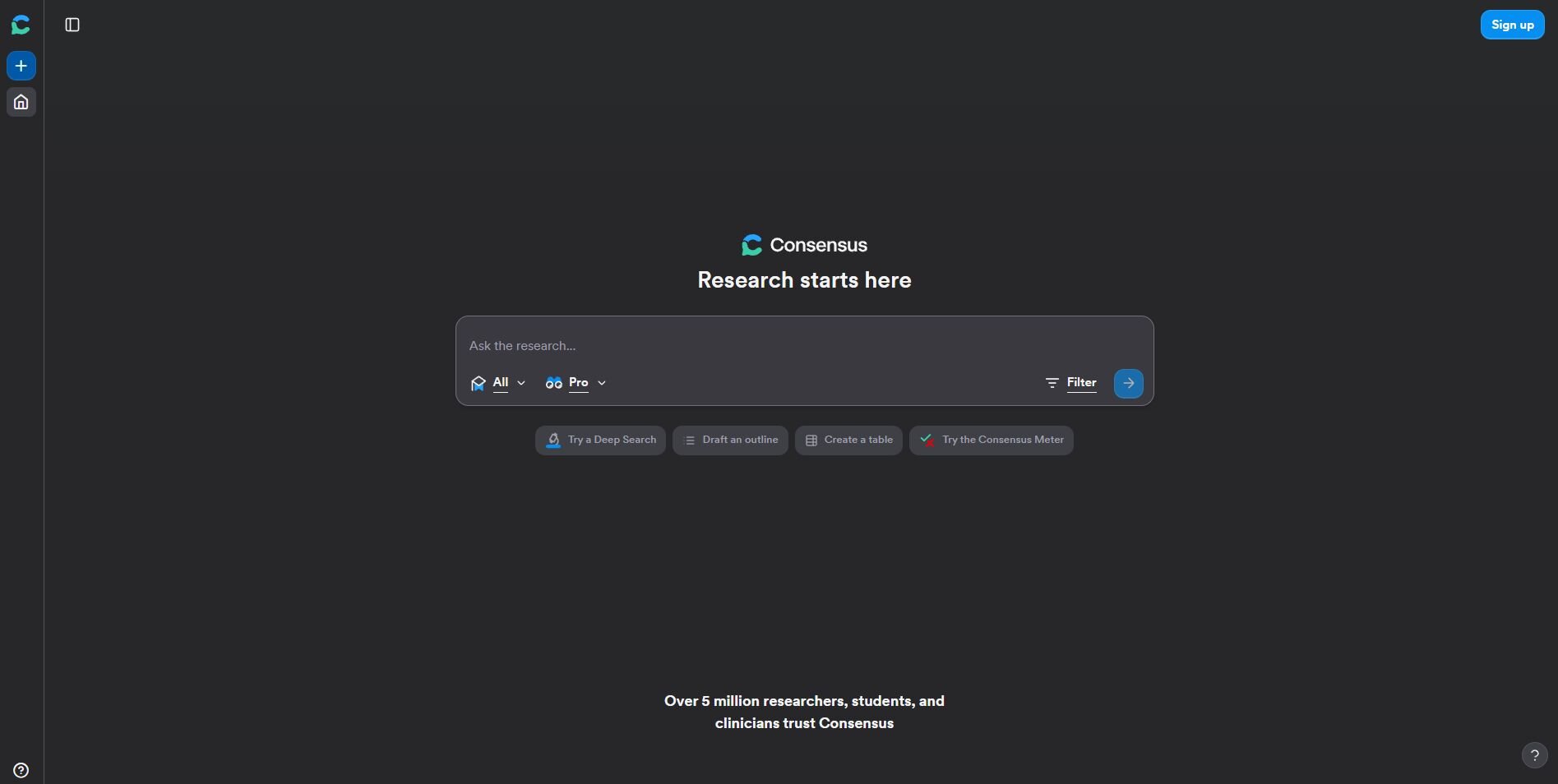
What it does: Consensus searches peer-reviewed papers and returns answers based on what published studies report. It highlights findings that support, oppose, or complicate a claim. It also summarizes key points from individual papers so you can review evidence quickly.
Who it’s for: Researchers who want quick, citation-backed answers.
I tried Consensus to see how quickly it could surface the general direction of the research around a question. The layout made it easy to see whether studies aligned or disagreed.
Looking through the summaries showed me what each paper contributed without needing to open everything. I checked the highlights to get quick context, which helped decide whether a claim was supported strongly or only mentioned in passing.
What stood out most was how focused the tool stayed on peer-reviewed material. It kept the results grounded and avoided unrelated sources, which made it easier to evaluate factual questions without sorting through noise.
Key features
Evidence summaries: See how studies answer a question
Paper highlights: Review findings quickly
Agreement indicators: View support or disagreement
Pros
Fast way to check scientific direction
Clear summaries tied to citations
Helpful for fact-based questions
Cons
Works less well for broad topics
Limited filtering options
Pricing
Consensus starts at $10 per month.
Bottom line
Consensus helps you understand how published studies answer a specific question without reading each paper first. If you want to explore how papers connect or evolve, Research Rabbit may be a better choice.
4. Research Rabbit: Best for exploring paper networks
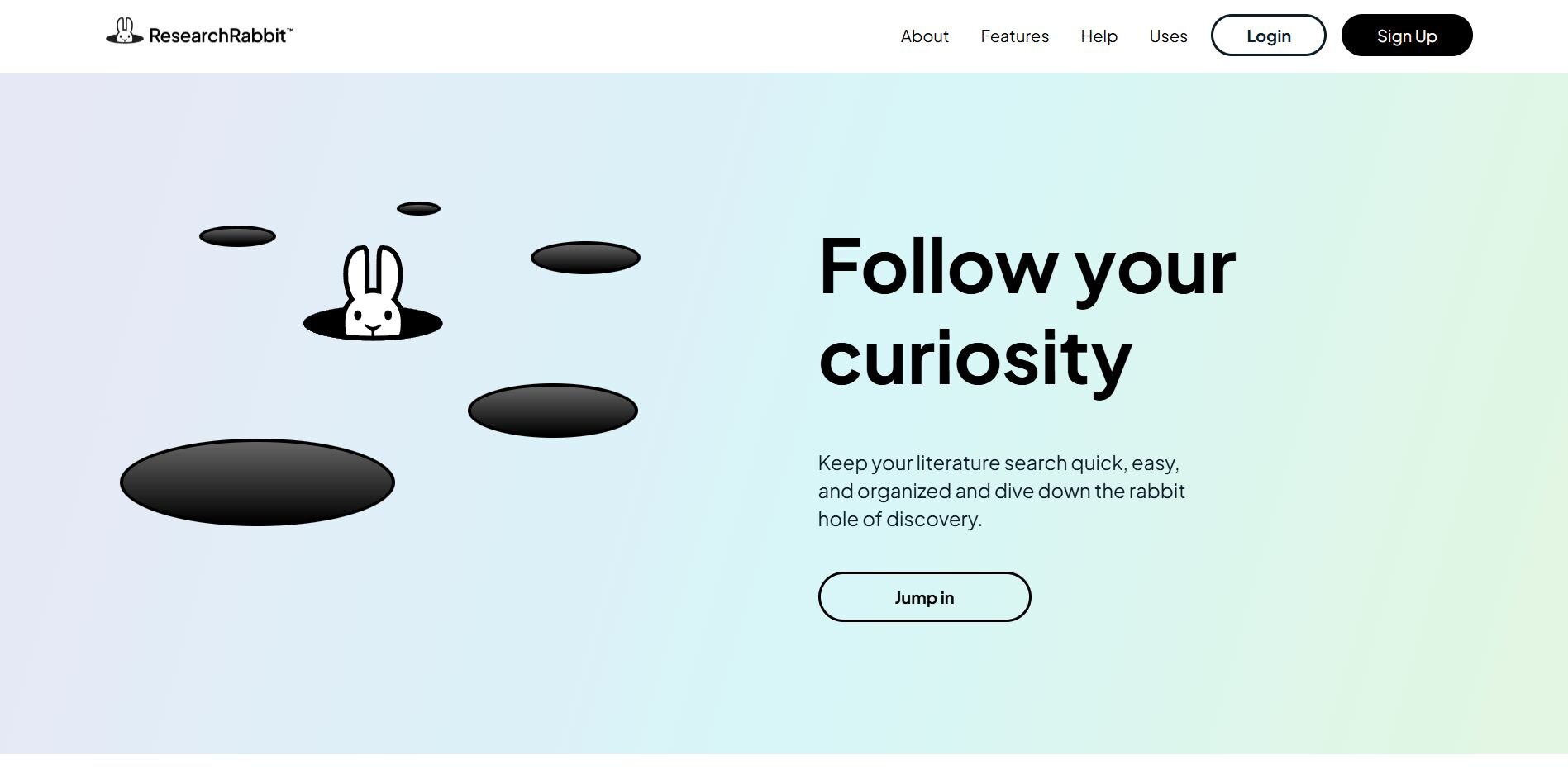
What it does: Research Rabbit visualizes how academic papers connect through citations, co-authorships, and related topics. You can add papers to a collection and explore networks that show how ideas develop across studies.
Who it’s for: Researchers who want to explore related work visually.
I used Research Rabbit to see how papers relate through citations, and the visual layout made those links clearer. Starting with one study and expanding outward showed which earlier papers informed it and which newer ones continued the discussion.
Reviewing the networks helped me see which topics came up most often and how different papers grouped together. I saved a set of studies into a collection and used the new suggestions to see which papers connected to my core topic. That made it easier to keep everything organized without rebuilding my research lists from scratch.
What stood out most was how quickly you can spot clusters and gaps. It’s helpful when you want a clear picture of the landscape before choosing which direction to explore more deeply.
Key features
Citation maps: Visualize how studies connect
Author networks: Explore co-authorship patterns
Collections: Track papers in organized groups
Pros
Great for exploring research areas
Helpful for identifying related work
Collection updates keep projects current
Cons
No paper summaries
Limited filtering for niche topics
Pricing
Research Rabbit starts at $120 per year.
Bottom line
Research Rabbit helps you explore how studies connect, which is useful when you want context around a field. If you need structured summaries, Elicit or SciSpace offer more detail.
5. Scite: Best for verifying claims
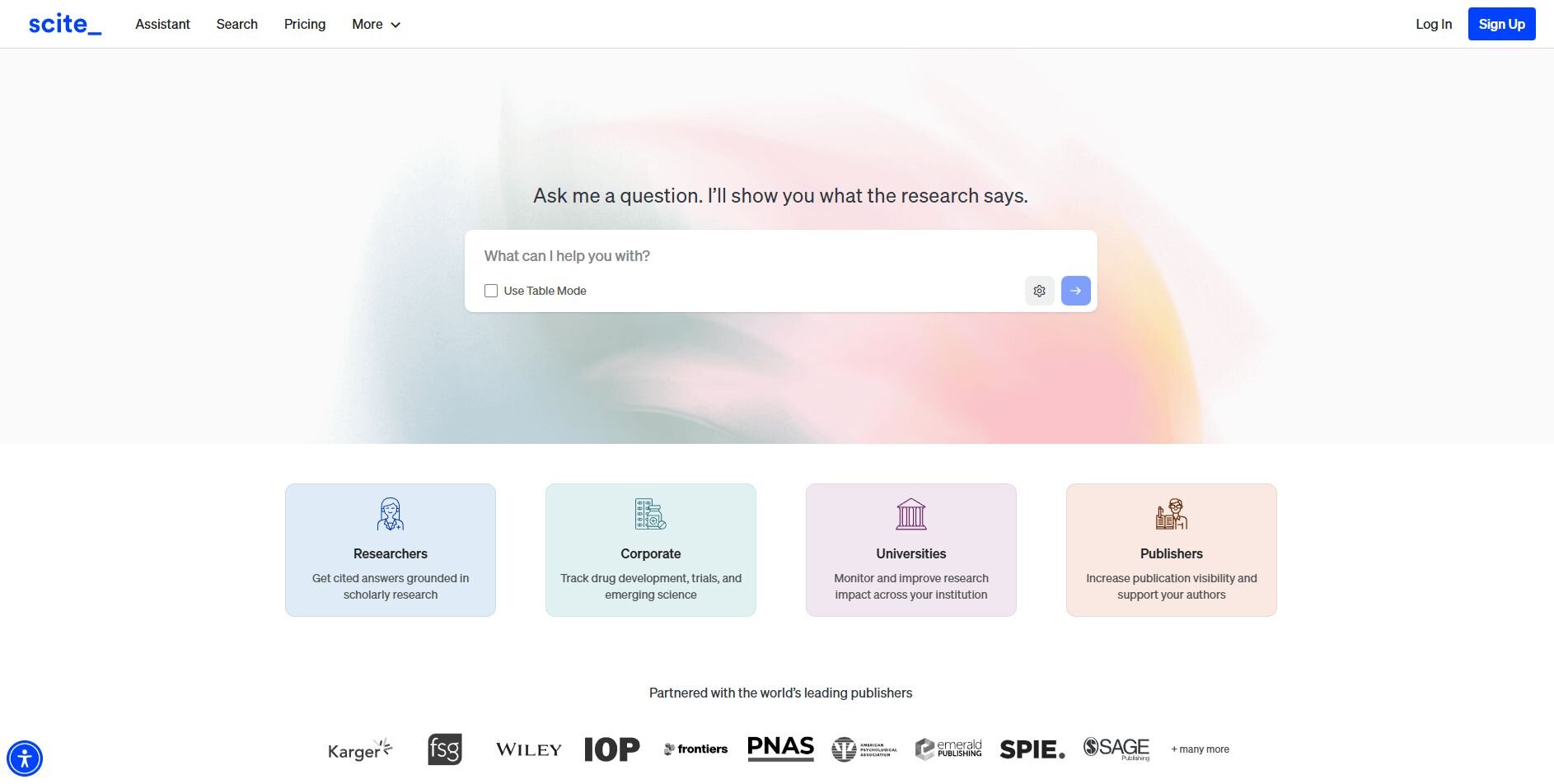
What it does: Scite is an AI tool for academic research that analyzes how papers are cited and shows whether later studies support, dispute, or simply mention the original work. It provides citation snippets so you can understand the context behind each reference.
Who it’s for: Researchers who need to verify claims made in academic work.
Testing Scite gave me a clear view of how newer studies responded to specific claims. Its grouping of supportive, critical, and neutral citations showed each paper’s position at a glance and helped me see whether a claim held up across follow-up research or needed closer review.
What helped most were the citation snippets. Seeing the surrounding text showed how each paper used the reference, and that extra context made disagreements or limitations much easier to spot. It also reduced the need to open several PDFs during early review.
Key features
Smart citations: View supporting or disputing references
Citation snippets: Read context around each claim
Study filters: Narrow by journal or study type
Pros
Clear view of evidence strength
Helpful citation context
Good for verifying claims in detail
Cons
Limited access on the free tier
May not index the newest papers
Pricing
Scite starts at $12 per month.
Bottom line
Scite helps you confirm whether a paper’s claims hold up by showing how later studies interpret or challenge them. If your work depends more on source discovery, tools like Research Rabbit or Keenious may fit better.
6. Perplexity: Best for quick topic scans

What it does: Perplexity is an AI search tool that answers questions with citations pulled from real-time web sources. It highlights supporting links so you can check credibility before using an answer. It also offers focused research views that group related subtopics.
Who it’s for: Researchers who need fast, source-linked context.
Using Perplexity helped me get quick background info on unfamiliar topics. The linked citations kept answers grounded and the structure saved time when I only needed a high-level view.
What stood out was how the focused mode grouped definitions, trends, and related subtopics into a clear flow. That made it easier to compare multiple sources without jumping across several tabs.
Perplexity also handled deeper follow-up questions well, but I found it most useful at the start of a research process. It gave me enough context to decide which sources were worth deeper review.
It’s also practical when your work doesn’t require academic sources, since the citations and focused results give you reliable context without needing formal studies.
Key features
Cited answers: Links to source material
Focus mode: Groups related subtopics
Real-time search: Pulls current information
Pros
Useful for early-stage orientation
Clear sourcing
Fast responses
Cons
Limited for academic depth
May repeat similar sources
Pricing
Perplexity starts at $20 per month.
Bottom line
Perplexity helps you get fast background context backed by citations. If you need academic summaries, Elicit or Consensus may serve you better. Julius is a stronger fit when your research involves structured data or you want visual analysis without writing queries.
7. Keenious: Best for paper recommendations

What it does: Keenious analyzes uploaded documents and suggests academic papers based on topic similarity. It uses the structure of your text to locate relevant sources in large scholarly databases. It also groups recommendations by theme so you can explore different angles.
Who it’s for: Researchers who want paper suggestions based on their own writing.
Uploading early drafts into Keenious gave me a better sense of which papers were most aligned with my direction. The recommendations surfaced themes that keyword search alone didn’t catch.
Preview summaries made it easier to decide which studies were worth opening. The topic clusters also helped separate central ideas from side topics without making things more complicated.
Keenious worked best when the input text was focused. More specific writing produced tighter recommendations that supported a clearer research direction.
Key features
Document-based recommendations: Uses your writing for matching
Thematic groups: Explore different angles
Paper previews: Review summaries at a glance
Pros
Great for early-stage exploration
Tailored to your writing
Easy to scan thematic groups
Cons
Broad drafts lead to broad suggestions
Limited filtering options
Pricing
Keenious starts at $10 per month.
Bottom line
Keenious helps you find relevant papers by analyzing your own writing instead of relying only on keywords. If you want visual mapping, Research Rabbit may offer more clarity.
8. SciSpace: Best for reading and questioning PDFs
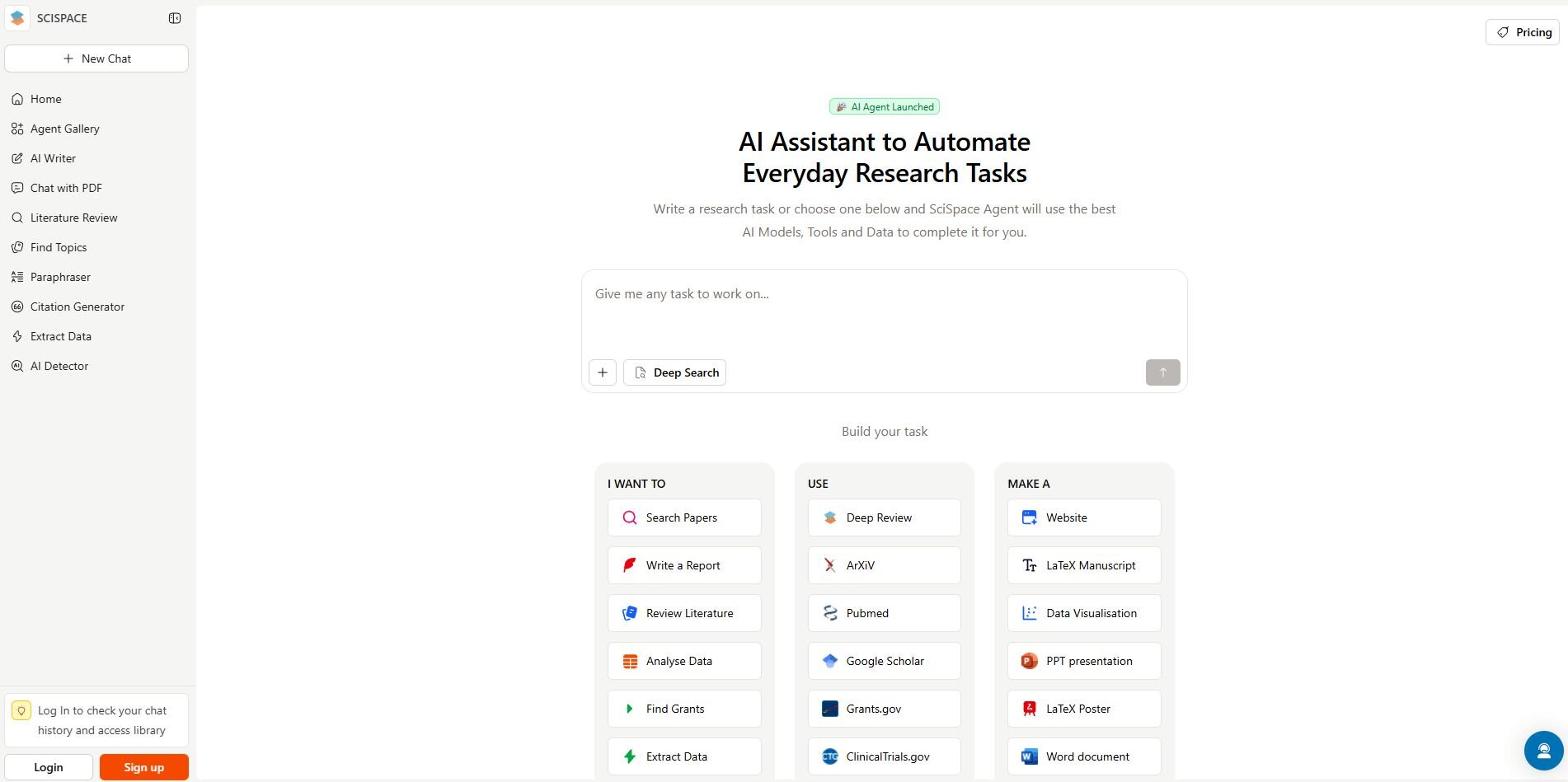
What it does: SciSpace uses AI to explain research papers, break down methods, and answer questions about uploaded PDFs. It highlights key sections of a document so you can understand how each part contributes to the study. It also supports natural language queries for deeper clarification.
Who it’s for: Researchers who want help reading and interpreting academic papers.
My first impression of SciSpace came from uploading a dense PDF and seeing how quickly it highlighted the exact section that answered my question. That jump saved me from scrolling through pages of methods and tables.
I noticed the explanations were helpful with statistical terms and research design details. They broke down language that normally slows the reading process, and the follow-up prompts kept everything moving.
SciSpace was useful when I only needed clarity on a specific part of a paper. It offered enough direction to understand the section without relying on a full summary.
Key features
PDF explanations: Break down complex sections
Question answering: Ask about methods or results
Highlighted references: Jump to relevant lines
Pros
Good for understanding dense papers
Useful for follow-up questions
Clear references to document sections
Cons
May miss nuance in complex studies
Works better on PDFs with clean formatting
Pricing
SciSpace starts at $12 per month.
Bottom line
SciSpace helps you understand the structure and reasoning within a research paper by pointing you to relevant sections. Tools like Scite or Consensus can add context when you need evidence checks.
9. ChatPDF: Best for summaries from documents
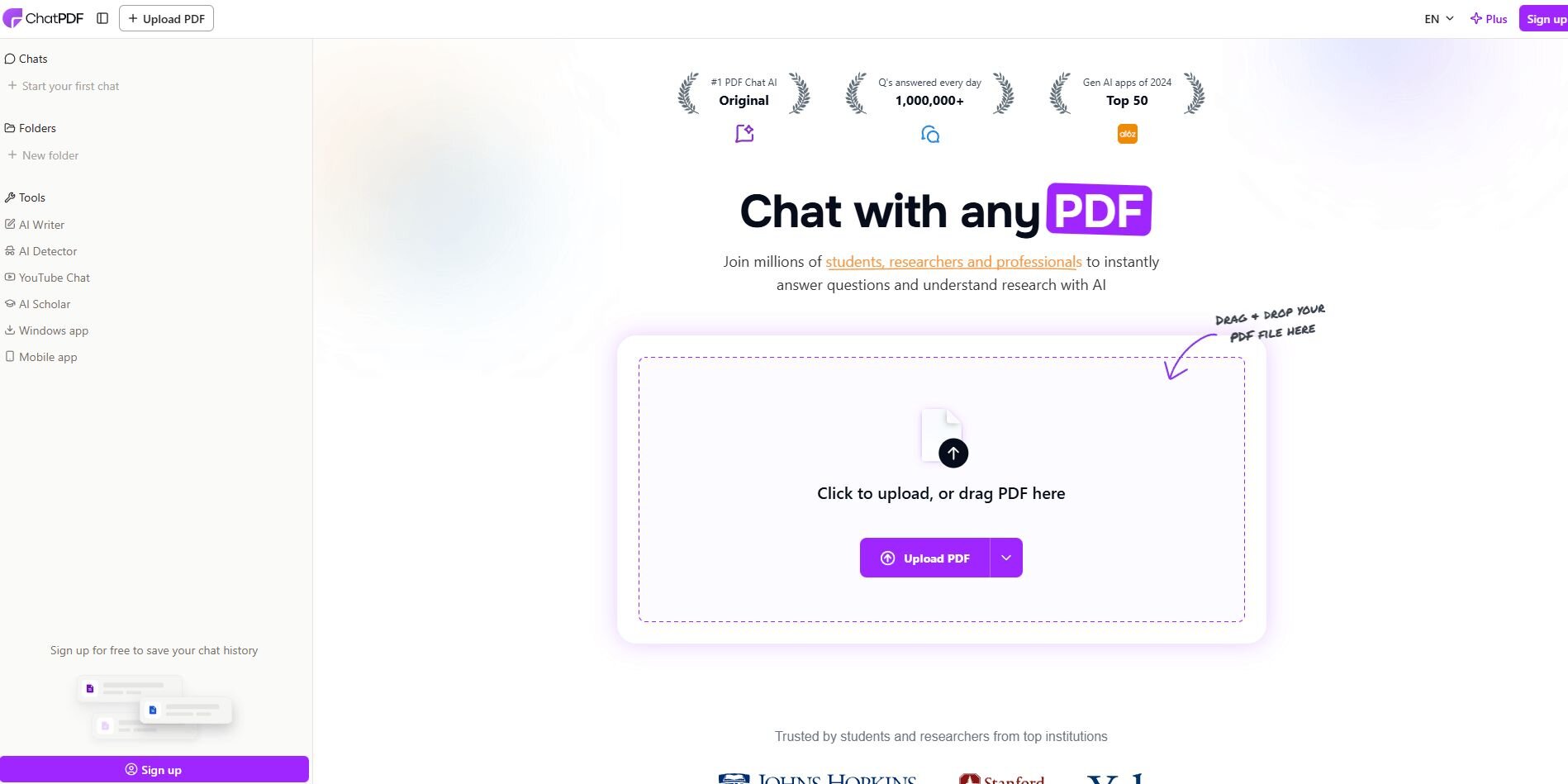
What it does: ChatPDF summarizes uploaded PDFs and answers questions about their content. It extracts sections, key points, and definitions so you can scan long documents more quickly. It also supports follow-up questions that help you explore specific themes.
Who it’s for: Researchers who need simple summaries from documents.
The first thing I checked in ChatPDF was how well it summarized long documents, and the quick overview made it clear which papers were worth a closer look. It saved time when I had a large stack to get through.
What helped most were the extracted sections. They highlighted the parts of the document that mattered, and the follow-up questions added detail when a concept wasn’t clear in the summary.
ChatPDF worked well when I needed a fast read on a long report. It helped me sort long documents quickly so I could choose what to read next.
Key features
Document summaries: Quick high-level views
Question answering: Explore topics inside the PDF
Section referencing: Jump to important parts
Pros
Simple for quick reviews
Helpful follow-up questions
Works on many document types
Cons
Limited depth
Not a replacement for detailed reading
Pricing
ChatPDF starts at $8.25 per month.
Bottom line
ChatPDF gives you quick summaries and basic explanations from long PDFs. If you need more structured analysis, SciSpace may offer more depth.
10. Scholarcy: Best for summarizing research papers
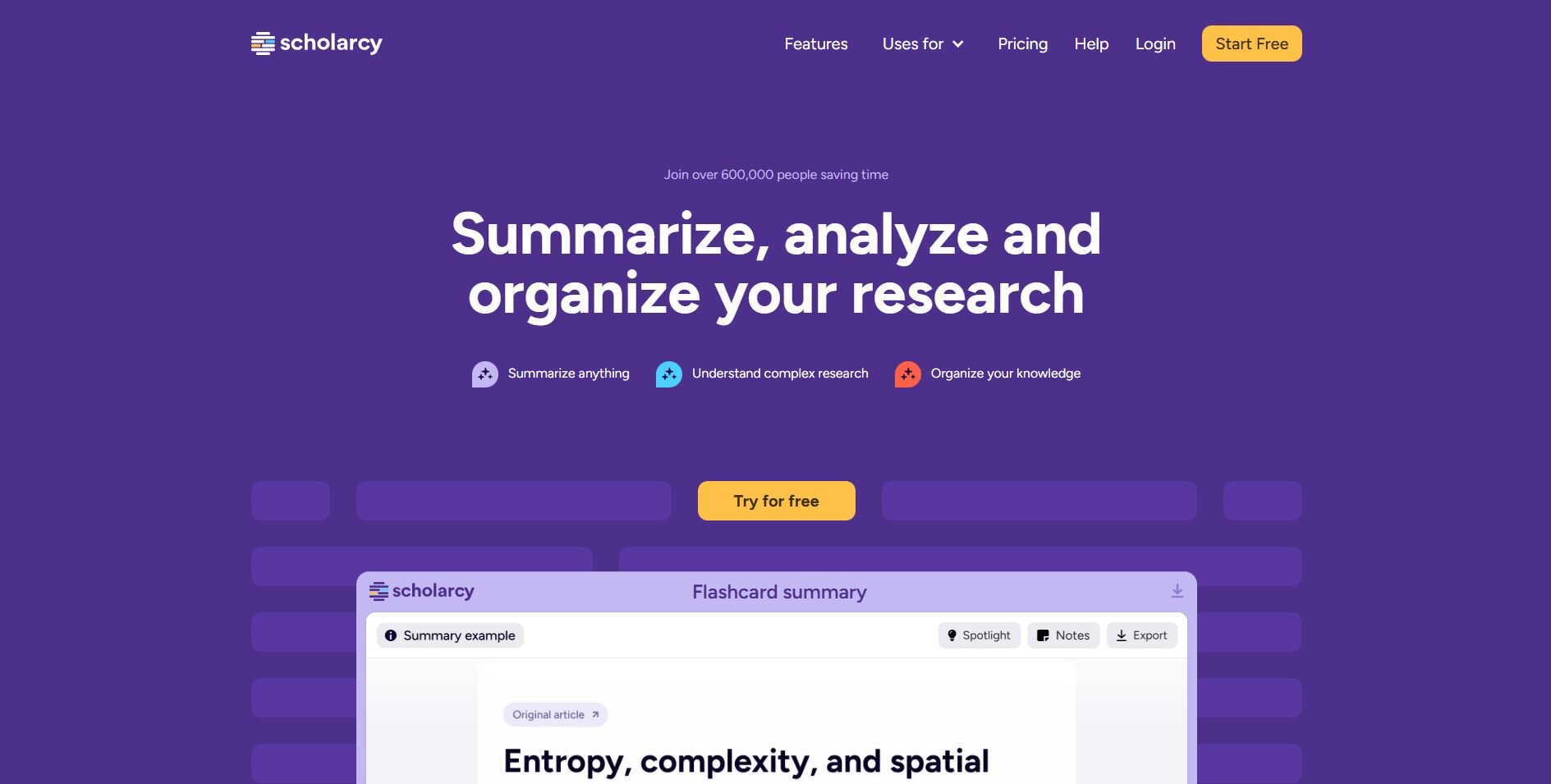
What it does: Scholarcy uses AI to summarize academic papers, highlight key points, and extract methods, results, and references. It creates a structured “flashcard” for each document so you can review long PDFs in minutes. It also links to cited studies for quick follow-up reading.
Who it’s for: Researchers who want quick, reliable summaries before reading full papers.
My first run with Scholarcy showed how fast it breaks down long papers into digestible sections. The flashcard format highlighted objectives, methods, and findings in a way that made early review easier and less overwhelming.
What stood out was how it handled dense sections that normally slow down the reading process. Scholarcy highlighted important terms and clarified complex parts of the text, which helped when I needed to review several papers at once.
Scholarcy is a practical option in AI for research, especially when you want quick structure before committing to a full read.
Key features
AI flashcards: Summarize long papers into key sections
Reference extraction: Pulls cited studies for quick follow-up
Highlighting: Surfaces objectives, findings, and methods
Pros
Fast summaries
Easy to compare multiple papers
Helpful for early screening
Cons
Works best on clean PDFs
Not a replacement for full reading
Pricing
Scholarcy starts at $90 per year.
Bottom line
Scholarcy helps you scan academic papers quickly by turning long PDFs into clear summaries with highlights and references. If you want deeper explanations or section-level answers, SciSpace may be a better match.
How I tested these AI tools for research
I tested each tool by running it through common research tasks like topic exploration, paper verification, and structured data review. This helped me see how well each platform handled real inputs, not staged demos, and whether the results were reliable enough to use in actual projects.
Another thing I checked was how quickly the tools produced clear context, how transparent they were about their sources, and whether their outputs stayed consistent across different document types. I also looked at how they supported research integrity when reviewing claims, citations, and methods.
Here are the main criteria I used during testing:
Time to clarity: How fast the tool produced something specific enough to guide the next step.
Source review: Whether I could inspect citations, references, tables, or linked studies without extra digging.
Handling of long documents: How well the tool processed PDFs with multiple sections, charts, or technical language.
Quality of follow-up answers: Whether deeper or more precise questions produced useful responses.
Support across research stages: How well the tool performed during scanning, summarizing, verifying, or analyzing.
Tradeoffs: Where another platform clearly did the job better or with fewer steps.
This approach made the differences between tools clearer and helped rank them based on what they deliver during actual research work.
Which AI research tool should you choose?
The right choice depends on the type of work you handle and how you prefer to review information. Some tools help you scan topics, others focus on academic papers, and some support structured data or claim verification. Choose:
Julius if your research includes connected datasets and you want quick analysis, charts, and repeatable checks without coding.
Elicit if you want organized summaries that help narrow broad topics early.
Consensus if your questions depend on evidence pulled directly from peer-reviewed studies.
Research Rabbit if you want a visual way to explore related papers and see how ideas connect.
Scite if you need to confirm whether a claim is supported, disputed, or simply mentioned in later research.
Perplexity if you want fast background context with linked citations before moving into deeper study.
Keenious if you want paper recommendations based on your draft, notes, or early writing.
SciSpace if you need help understanding the methods and structure inside dense PDFs.
ChatPDF if you want simple summaries and quick explanations from long documents.
My final verdict
I’ve noticed that people running literature reviews tend to lean toward Elicit or Consensus, while anyone exploring how papers relate usually turns to Research Rabbit. SciSpace and Scholarcy fit users who want quicker insight into long PDFs without reading everything up front.
Julius fits the gap those tools leave open by giving you a faster way to work with structured data and see clear patterns without writing SQL. I’ve found that this helps when your research goes beyond documents and needs reliable charts or recurring checks you can trust.
See how Julius uses AI to help you analyze research data
Many AI tools for research help with documents or source discovery, but research projects still slow down when your data sits in spreadsheets or disconnected files. Julius lets you explore structured data by asking clear questions and getting visuals, summaries, and recurring updates without writing SQL.
Here’s how Julius helps with financial data visualization and reporting:
Quick single-metric checks: Ask for an average, spread, or distribution, and Julius shows you the numbers with an easy-to-read chart.
Built-in visualization: Get histograms, box plots, and bar charts on the spot instead of jumping into another tool to build them.
Catch outliers early: Julius highlights values that throw off your results, so decisions rest on clean data.
Recurring summaries: Schedule analyses like weekly revenue or delivery time at the 95th percentile and receive them automatically by email or Slack.
Smarter over time: With each query, Julius gets better at understanding how your connected data is organized. It learns where to find the right tables and relationships, so it can return answers more quickly and with better accuracy.
One-click sharing: Turn a thread of analysis into a PDF report you can pass along without extra formatting.
Direct connections: Link your databases and files so results come from live data, not stale spreadsheets.
Ready to see how Julius helps you turn research data into charts and summaries you can act on? Try Julius for free today.
